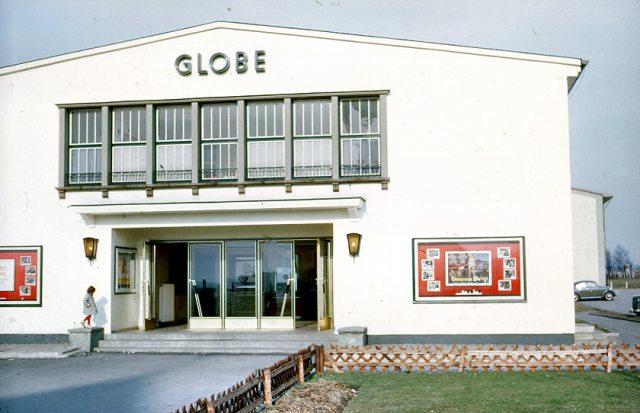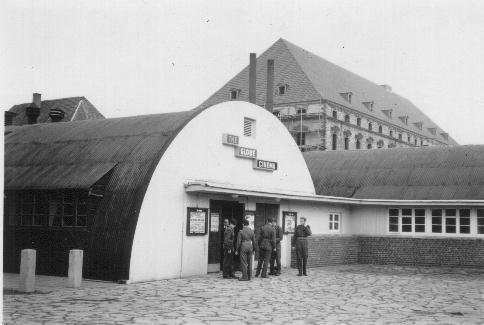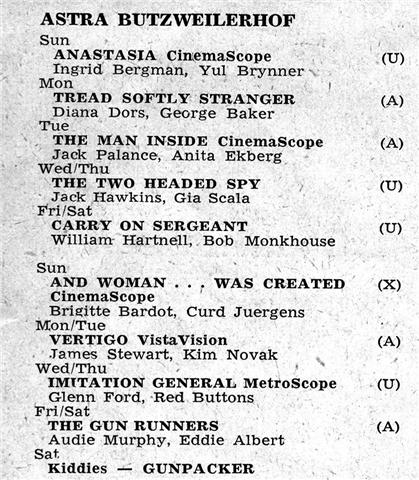Originally during the Second World War, part of E.N.S.A. (Entertainments National Services Association). After the war, this part separated and became The Army Kinema Corporation (AKC).
In 1958 the headquarters of the AKC in London, was at 36 Dover Street, London. The organization came under the umbrella of the War Office (at that time). In 1958 the headquarters of the AKC in BAOR was situated in Kingsley Barracks, Minden, BFPO 29 (11th Infantry Brigade, 1st British Corps). This included the film vaults, film distribution centre, and workshops. Most of the senior head office staff, i.e. the District Director, Deputy Director, Personnel Manager, and Circuit Supervisors (one for the north, and one for the South). All of these had Officer Status, which entitled them to use the Officers’ Mess wherever they were.
Other staff (like myself) such as the three or four British based Relief Projectionists and Managers, plus the Static Managers at each location, all had WOs’ and Sgts’ Status. This entitled them to messing facilities in the WOs’ and Sgts’ Mess (accommodation/meals). This also applied on both troopships and trains.
Most British staff were all ex-service personnel. Film distribution throughout the two circuits was both on a Monday and a Thursday. This was when programmes were moved on to the following cinema on the circuit. This was done by road.
The two Circuit Supervisors who looked after the two circuits, were based at both Minden (north) and in Rheindahlen, (south). The Royal Air Force had its own independent cinema organization, this was called “Astra” and involved about 12 Astra Cinemas on RAF bases throughout BAOR.

Here is a picture of one of my theatres: “The Globe Fort Prince of Wales” Deilinghoven, near Hemer, taken in the 1960s. It is typical example of a post war built cinema/camp.
Courtesy of a former Canadian soldier.
In February 1958, there were approximately 48 cinemas operated by the AKC in BAOR. In general, most were located in barracks. Münster, for example, was not. This Globe cinema was located in the former Hauptbahnhof Kino (main railway station).
For the other cinemas, they were located in the following centres, and to the best of my memory they were-
Bad Oeynhausen, Bergen/Hohne (in the Roundhouse), Berlin, Bielefeld, Birgelen/Wassenberg (Mercury Barracks), Bünde (Birdwood Barracks), Celle, Delmenhorst (St Barbara’s Barracks), Detmold (Hobart Barracks), Dortmund (two cinemas, Camp 7 and Napier Barracks), Düsseldorf, Essen-Kray (Meeanee Barracks), Fallingbostel, Hameln, Hamm, Hannover (Langenhagen Barracks), Hemer, Herford, Hilden, Hildesheim, Iserlohn, Köbecke/Möhnesee (Fort St Louis), Krefeld, Lemgo (Stornoway Barracks, Lippstadt, Menden, Minden, Mönchengladbach/Rheindahlen, Münster, Munsterlager, Neumünster, Osnabrück, Paderborn, Plön (on request only. King Alfred School, 1949-59), Sennelager (Theatre Barracks), Soest (Fort Chambly), Verden, Werl (Fort York).
Without a doubt there were others, but I was never fortunate enough to be able to get a posting to any others.
In general most of the cinemas were seated to hold about a maximum of approximately 200 patrons, but of course there were exceptions. Some of the cinemas had been established in existing buildings, such as in Hobart Barracks in Detmold, while others were especially built, such as at Birdwood Barracks, Bünde.
Again in general throughout BAOR, all the cinemas were equipped with German 35mm Bauer B8 Projectors. this included the latest Telefunken Stereophonic sound. The only exception that I am aware of, was Delmenhorst, which was equipped with 16mm Ernemann 7b projectors. About twice a year, a German service engineer by the name of Harry Wehrmann, would arrive at each theatre to do maintenance on the equipment. He was an extremely nice fellow who at one time had worked during the war on U-Boats.

The Globe Cinema at Roberts Barracks, Osnabrück, 1952
Courtesy of Tony Burgess 22414720 RE
Most of the Globe cinemas in BAOR employed local people. This was in reference to the projectionists or operators, they were often in the main local squaddies from the barracks. At some locations, there was both a German projectionist and a squaddie. In such times as when the squaddies were away on manoeuvres, or the German operator was away sick or on leave, head office would post one of the four British based relief operators to the theatre, that is until the staff returned. This also applied to the managers as they had reliefs as well. In times of emergency, both were able to stand in for the other, that is until a relief was sent from elsewhere. The front of house staff, such as the cashier and the candy bar were, in the main, wives of servicemen, with only the cleaner being German.
Courtesy of Edward Wilson, 1st Bn Border Regiment
In reference to AKC service vehicles were painted a dark olive green. On the side of the vehicle was written in full, “The Army Kinema Corporation”. All the vehicles were licensed as BZ vehicles at the time. Only when upper management was doing the rounds on a tour of inspection, did they use ordinary vehicles such as a plain black Mercedes.
All the British based staff, the relief managers and operators and the static managers carried authorisation in the form of a large red stamp in their passports. This was issued at the time by the War Office. This gave authorisation to the holder to visit units throughout BAOR. The stamp was as follows- “Number 25428, Certificate, Name Mr J.P. O’Meara. Is a member of the forces: United Kingdom and is entitled to unrestricted entry into and exit from the Federal Republic of Germany and Berlin. Signature of Issuing Officer, 23 Jan 1959”.
We were also issued with NAAFI cards, but for the few of us who were stationed with the Canadians, we had M.L.S. ration cards (Maple Leaf Stores), plus a Canadian ID pass.
During my time with the Army Kinema Corporation, the District Director was Brigadier John Snowden (ret). The Deputy Director was Major Wilson (ret), with the Personnel Manager being a Mr N.R. Ryecart. In summing up – Happy days!
Some years later, after I had resigned and left “The Army Kinema Corporation” in 1965, The “Royal Air Force Cinema Corporation” merged with The A.K.C and formed “The Services Kinema Corporation” (S.K.C). “The R.A.F. Cinema Corporation”, as with the “A.K.C.” had it’s origins in E.N.S.A. during the Second World War. In 1982, The S.K.C. was re-organized, and became “The Services Sound and Vision Corporation”, which it is still to this day. Nothing much can be found today of the former A.K.C. or S.K.C. in Germany. Most of the A.K.C. history has now been lost, with the former staff who knows where, many having passed on, or are now in their twilight years. Happy days!
Regards John O’Meara (ex-A.K.C. 1959-65)
The Astra Cinema at Butzweilerhof occupied what used to be the main terminal at Cologne’s pre-war international airport. Amazingly it survived the war and is safe from further harm in the (now protected and refurbished) terminal building. In the “Spotlight” magazine (produced for 2 TAF personnel) as well as news items, they also published the forthcoming programmes for the whole chain of Astra Cinemas in Germany.
Colin Noad

The very impressive facade of the Astra Cinema Butzweilerhof

Courtesy of Colin Noad
